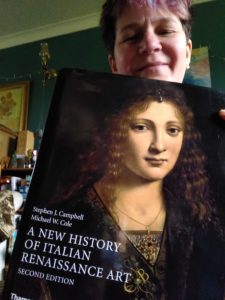What’s on our Shelves: A New History of Italian Renaissance Art by Stephen J. Campbell and Michael W. Col
2nd June 2023 | PTFS-Europe
I’ve always loved art and visiting art galleries, local and national, you never know quite what you are going to find, whether it’s an unexpected brace of Lowries (Lincoln gallery) to the room by room splendour of somewhere like the Prado or the National Gallery. Over the last few months though I’ve felt I needed a bit more structure to help me find my way through the centuries of creativity. Which brings me to my current reading – A new history of Italian Renaissance art by Stephen J. Campbell and Michael W. Cole. If you can’t visit, and are tired of zooming in on works on your tablet then this is a beautiful book – looking at renaissance art in Italy and art works made by Italians abroad from 1400 over two centuries.
It takes you through more or less decade by decade. Having progressed through Giotto, perspective and the Pisa Baptistry I’m now onto frescoes and just started 1460 to 1470 on Courtly values. In this chapter I’ve been transported to my year out long ago visiting Arezzo and Florence. There are prints of the glorious Benozzo Gozzoli Procession of the Magi – but also the context of where they are hung in situ – in this case in a small room in the Medici Palace. I love these structural works where the artist combines a religious or mythological saga with vignettes of the patrons who commissioned the work – in this case members of the Medici family – it’s like a modern day selfie “Here’s me with the Magi”. This is a weighty tome, and as you might guess from the photo, it’s actually quite heavy too! It is beautifully put together and totally fulfils the back page blurb as it “surveys the canon of Renaissance painting and sculpture in full”.
Canon is an interesting word here. I’ve also been attending a series of National Gallery online art history courses which have been aimed at pursuing different readings of art, such as social, decolonised, feminist and LBGQT+ approaches. Before I began these courses I had not been aware of the number of renaissance women painters (for example Lavinia Fontana, Sofonisba Anguissola, Catharina van Hemessen, Lavinia Teerlinc) – women artists who until relatively recently have not been part of the “canon”, though in actuality were hugely successful in their time. My current read does have a section on Sofonisba, but in terms of interpretation, the book takes a conventional approach, don’t expect any deconstructed readings! However as a set of building blocks for study and if you love to marvel at glorious paintings and buildings I’d recommend it.

Janet McGowan- Director of Operations